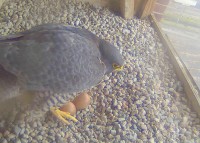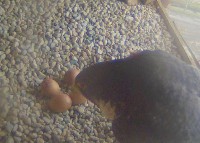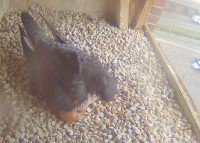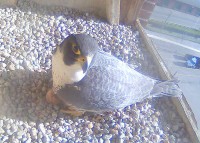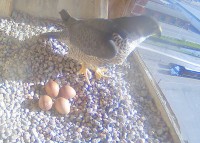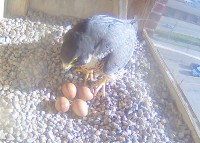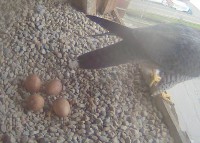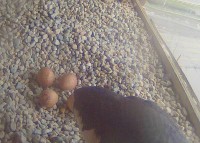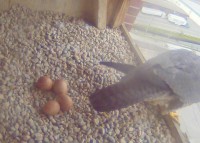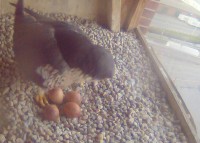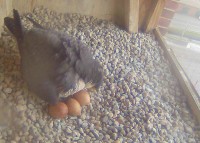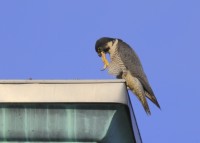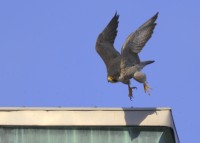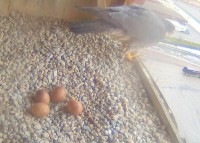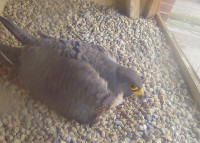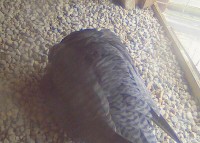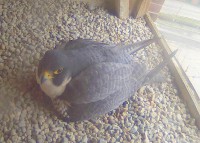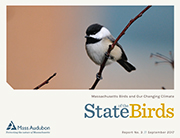Lawrence Peregrines: before hatching?
May 8, 2018 in In the Nest Box, lawrence peregrines, Peregrine Falcons Eastern Massachusetts, Peregrine Falcons Massachusetts
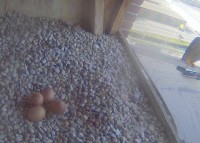 This morning the peregrines started the morning with a bit of fog, light winds from the NE, and temp at 46F. The day ahead calls for sunny skies, with a high near 71. Calm wind becoming south 5 to 8 mph in the afternoon. At 6:44 AM the male was incubating the eggs, and acted in usual restless way. He moved around quite a bit, shaking side to side, and rocking back and forth, nibbling at bits of gravel, and turning. A bit later as the sun came out after the morning fog, the female was seen outside the nest box on the perch….another sign that hatching is close!
This morning the peregrines started the morning with a bit of fog, light winds from the NE, and temp at 46F. The day ahead calls for sunny skies, with a high near 71. Calm wind becoming south 5 to 8 mph in the afternoon. At 6:44 AM the male was incubating the eggs, and acted in usual restless way. He moved around quite a bit, shaking side to side, and rocking back and forth, nibbling at bits of gravel, and turning. A bit later as the sun came out after the morning fog, the female was seen outside the nest box on the perch….another sign that hatching is close!
We are getting a lot of questions about eggs and hatching. It takes about 29-31 days for Peregrine Falcon eggs to hatch, 35-37 days for Bald eagle eggs to hatch, and about 28 days for great horned owl eggs to hatch. Despite the differences in incubation times, very similar things happen in the eggs of all three species.
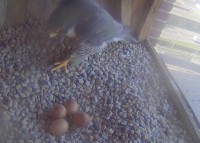 What happens within the egg shortly before hatching starts?
What happens within the egg shortly before hatching starts?
The rapidly developing embryo…
- Grows large enough to take up nearly all the space.
- Positions its body so that its head is at the large end of the egg next to the air space.
- Begins to breathe with its lungs. Ever crack an egg and see the white membrane inside? Before the chick pokes its beak through this membrane into the air space, a special tissue called the CAM supplies oxygen to the developing embryo. Gases, including oxygen, leave and enter the egg by diffusing through the pores in its shell, across the outer and inner shell membranes, and into the blood in the capillaries of the CAM. From there, the blood circulates through the embryo and provides it with oxygen – no lungs required until the membrane is broken.
- Consumes most of the remaining albumen and yolk. When I was young, I thought that birds formed from the yolk. Not so! The yolk provides food and energy for the embryo.
The chart below outlines major developmental points in the lifecycle of a developing chicken embryo. At 20 days, the chicken is almost large enough to break the membrane and begin hatching. The timing would be a little different in the case of Bald eagles, Canada geese, and Great Horned owls, but the stages of development are the same.
Literature cited:
The Raptor Research Project, Raptor Research Project Blog, Saturday, March 10, 2012 https://raptorresource.blogspot.com/2012/03/
